
Willows, also called sallows and osiers, of the genus Salix, comprise around 350 species of typically deciduous trees and shrubs, found primarily on moist soils in cold and temperate regions.

Salix alba, the white willow, is a species of willow native to Europe and western and central Asia. The name derives from the white tone to the undersides of the leaves.

Salix caprea, known as goat willow, pussy willow or great sallow, is a common species of willow native to Europe and western and central Asia.

Salix purpurea, the purple willow, purpleosier willow, or purple osier, is a species of willow native to most of Europe and western Asia north to the British Isles, Poland, and the Baltic States.

Salix × fragilis, with the common names crack willow and brittle willow, is a hybrid species of willow native to Europe and Western Asia. It is native to riparian habitats, usually found growing beside rivers and streams, and in marshes and water meadow channels. It is a hybrid between Salix euxina and Salix alba, and is very variable, with forms linking both parents.

Salix viminalis, the basket willow, common osier or osier, is a species of willow native to Europe, Western Asia, and the Himalayas.
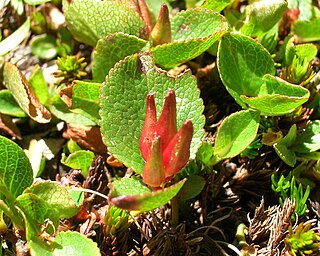
Salix herbacea, the dwarf willow, least willow or snowbed willow, is a species of tiny creeping willow adapted to survive in harsh arctic and subarctic environments. Distributed widely in alpine and arctic environments around the North Atlantic Ocean, it is one of the smallest woody plants.

A catkin or ament is a slim, cylindrical flower cluster, with inconspicuous or no petals, usually wind-pollinated (anemophilous) but sometimes insect-pollinated. They contain many, usually unisexual flowers, arranged closely along a central stem that is often drooping. They are found in many plant families, including Betulaceae, Fagaceae, Moraceae, and Salicaceae.
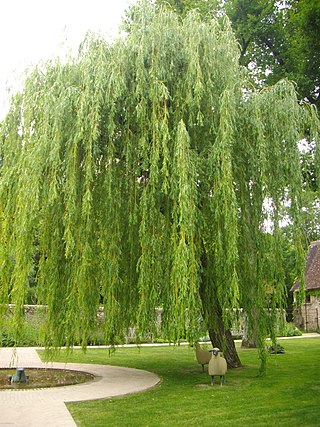
Salix babylonica is a species of willow native to dry areas of northern China, but cultivated for millennia elsewhere in Asia, being traded along the Silk Road to southwest Asia and Europe.

Salix cinerea is a species of willow native to Europe and western Asia.
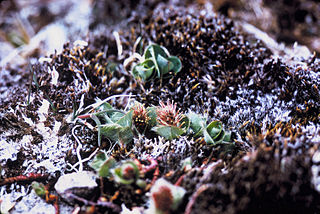
Salix arctica, the Arctic willow, is a tiny creeping willow. It is adapted to survive in Arctic conditions, specifically tundras.

Salix nigra, the black willow, is a species of willow native to eastern North America, from New Brunswick and southern Ontario west to Minnesota, and south to northern Florida and Texas.

Salix lasiolepis is a species of willow native to western North America.
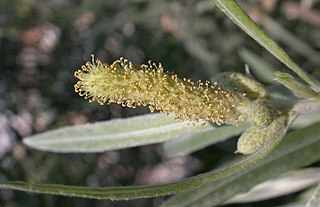
Salix exigua is a species of willow native to most of North America except for the southeast and far north, occurring from Alaska east to New Brunswick, and south to northern Mexico. It is considered a threatened species in Massachusetts while in Connecticut, Maryland, and New Hampshire it is considered endangered.

Salix triandra, with the common names almond willow, almond-leaved willow or black maul willow, is a species of willow native to Europe and Western and Central Asia. It is found from south-eastern England east to Lake Baikal, and south to Spain and the Mediterranean east to the Caucasus, and the Alborz Mountains. It usually grows in riparian habitats, on river and stream banks, and in wetlands.
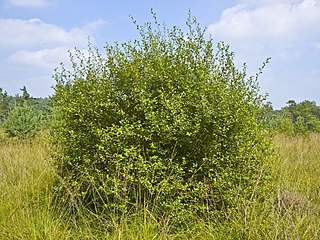
Salix aurita, the eared willow, is a species of willow distributed over much of Europe, and occasionally cultivated. It is a shrub to 2.5 m in height, distinguished from the similar but slightly larger Salix cinerea by its reddish petioles and young twigs. It was named for its persistent kidney-shaped stipules along the shoots.

Nomen illegitimum is a technical term used mainly in botany. It is usually abbreviated as nom. illeg. Although the International Code of Nomenclature for algae, fungi, and plants uses Latin terms as qualifiers for taxon names, the definition of each term is in English rather than Latin. The Latin abbreviations are widely used by botanists and mycologists.

Salix OS is a multi-purpose Linux distribution based on Slackware.

Salix repens, the creeping willow, is a small, shrubby species of willow in the family Salicaceae, growing up to 1.5 metres in height. Found amongst sand dunes and heathlands, it is a polymorphic species, with a wide range of variants. In the UK, at least, these range from small, prostrate, hairless plants at one end of the spectrum to taller, erect or ascending silky-leaved shrubs at the other. This wide variation in form has resulted in numerous synonyms.

Salix euxina, the eastern crack-willow, is a species of flowering plant in the willow family Salicaceae, native from Turkey to the Caucasus. It was first described by I. V. Belyaeva in 2009. It is one of the parents of the common crack-willow, Salix × fragilis.




















